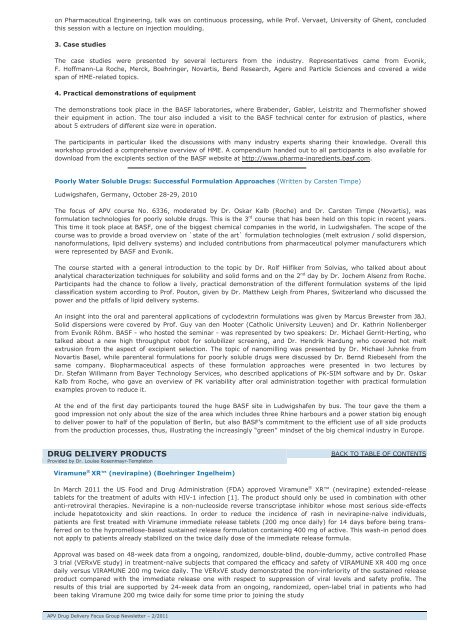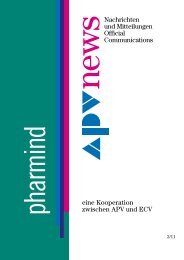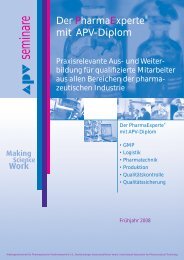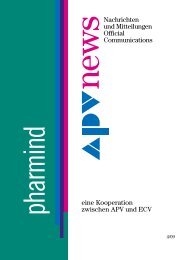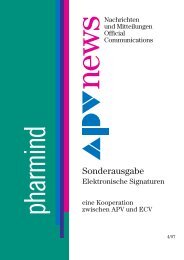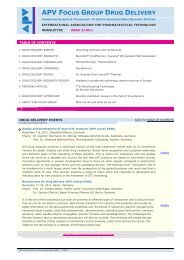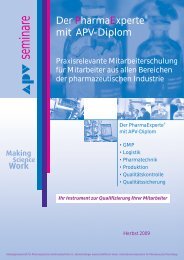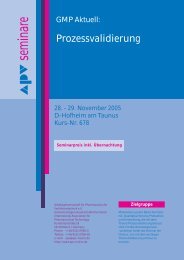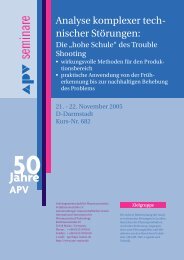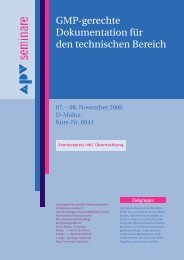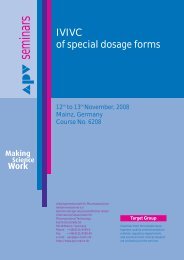APV FOCUS GROUP DRUG DELIVERY
APV FOCUS GROUP DRUG DELIVERY
APV FOCUS GROUP DRUG DELIVERY
You also want an ePaper? Increase the reach of your titles
YUMPU automatically turns print PDFs into web optimized ePapers that Google loves.
on Pharmaceutical Engineering, talk was on continuous processing, while Prof. Vervaet, University of Ghent, concluded<br />
this session with a lecture on injection moulding.<br />
3. Case studies<br />
The case studies were presented by several lecturers from the industry. Representatives came from Evonik,<br />
F. Hoffmann-La Roche, Merck, Boehringer, Novartis, Bend Research, Agere and Particle Sciences and covered a wide<br />
span of HME-related topics.<br />
4. Practical demonstrations of equipment<br />
The demonstrations took place in the BASF laboratories, where Brabender, Gabler, Leistritz and Thermofisher showed<br />
their equipment in action. The tour also included a visit to the BASF technical center for extrusion of plastics, where<br />
about 5 extruders of different size were in operation.<br />
The participants in particular liked the discussions with many industry experts sharing their knowledge. Overall this<br />
workshop provided a comprehensive overview of HME. A compendium handed out to all participants is also available for<br />
download from the excipients section of the BASF website at http://www.pharma-ingredients.basf.com.<br />
Poorly Water Soluble Drugs: Successful Formulation Approaches (Written by Carsten Timpe)<br />
Ludwigshafen, Germany, October 28-29, 2010<br />
The focus of <strong>APV</strong> course No. 6336, moderated by Dr. Oskar Kalb (Roche) and Dr. Carsten Timpe (Novartis), was<br />
formulation technologies for poorly soluble drugs. This is the 3 rd course that has been held on this topic in recent years.<br />
This time it took place at BASF, one of the biggest chemical companies in the world, in Ludwigshafen. The scope of the<br />
course was to provide a broad overview on `state of the art` formulation technologies (melt extrusion / solid dispersion,<br />
nanoformulations, lipid delivery systems) and included contributions from pharmaceutical polymer manufacturers which<br />
were represented by BASF and Evonik.<br />
The course started with a general introduction to the topic by Dr. Rolf Hilfiker from Solvias, who talked about about<br />
analytical characterization techniques for solubility and solid forms and on the 2 nd day by Dr. Jochem Alsenz from Roche.<br />
Participants had the chance to follow a lively, practical demonstration of the different formulation systems of the lipid<br />
classification system according to Prof. Pouton, given by Dr. Matthew Leigh from Phares, Switzerland who discussed the<br />
power and the pitfalls of lipid delivery systems.<br />
An insight into the oral and parenteral applications of cyclodextrin formulations was given by Marcus Brewster from J&J.<br />
Solid dispersions were covered by Prof. Guy van den Mooter (Catholic University Leuven) and Dr. Kathrin Nollenberger<br />
from Evonik Röhm. BASF - who hosted the seminar - was represented by two speakers: Dr. Michael Gerrit-Herting, who<br />
talked about a new high throughput robot for solubilizer screening, and Dr. Hendrik Hardung who covered hot melt<br />
extrusion from the aspect of excipient selection. The topic of nanomilling was presented by Dr. Michael Juhnke from<br />
Novartis Basel, while parenteral formulations for poorly soluble drugs were discussed by Dr. Bernd Riebesehl from the<br />
same company. Biopharmaceutical aspects of these formulation approaches were presented in two lectures by<br />
Dr. Stefan Willmann from Bayer Technology Services, who described applications of PK-SIM software and by Dr. Oskar<br />
Kalb from Roche, who gave an overview of PK variability after oral administration together with practical formulation<br />
examples proven to reduce it.<br />
At the end of the first day participants toured the huge BASF site in Ludwigshafen by bus. The tour gave the them a<br />
good impression not only about the size of the area which includes three Rhine harbours and a power station big enough<br />
to deliver power to half of the population of Berlin, but also BASF’s commitment to the efficient use of all side products<br />
from the production processes, thus, illustrating the increasingly “green” mindset of the big chemical industry in Europe.<br />
<strong>DRUG</strong> <strong>DELIVERY</strong> PRODUCTS BACK TO TABLE OF CONTENTS<br />
Provided by Dr. Louise Rosenmayr-Templeton<br />
Viramune ® XR (nevirapine) (Boehringer Ingelheim)<br />
In March 2011 the US Food and Drug Administration (FDA) approved Viramune ® XR (nevirapine) extended-release<br />
tablets for the treatment of adults with HIV-1 infection [1]. The product should only be used in combination with other<br />
anti-retroviral therapies. Nevirapine is a non-nucleoside reverse transcriptase inhibitor whose most serious side-effects<br />
include hepatotoxicity and skin reactions. In order to reduce the incidence of rash in nevirapine-naïve individuals,<br />
patients are first treated with Viramune immediate release tablets (200 mg once daily) for 14 days before being transferred<br />
on to the hypromellose-based sustained release formulation containing 400 mg of active. This wash-in period does<br />
not apply to patients already stabilized on the twice daily dose of the immediate release formula.<br />
Approval was based on 48-week data from a ongoing, randomized, double-blind, double-dummy, active controlled Phase<br />
3 trial (VERxVE study) in treatment-naïve subjects that compared the efficacy and safety of VIRAMUNE XR 400 mg once<br />
daily versus VIRAMUNE 200 mg twice daily. The VERxVE study demonstrated the non-inferiority of the sustained release<br />
product compared with the immediate release one with respect to suppression of viral levels and safety profile. The<br />
results of this trial are supported by 24-week data from an ongoing, randomized, open-label trial in patients who had<br />
been taking Viramune 200 mg twice daily for some time prior to joining the study<br />
<strong>APV</strong> Drug Delivery Focus Group Newsletter – 2/2011 Page 3 of 15


